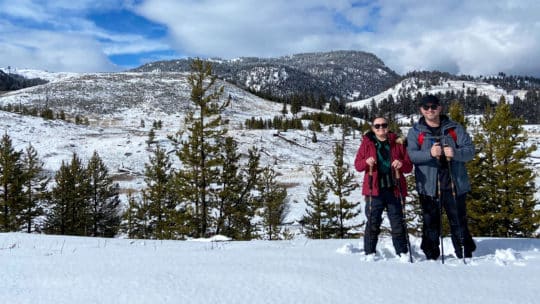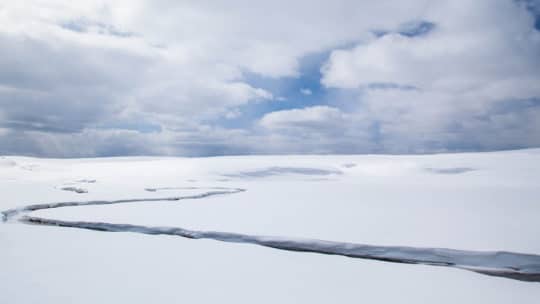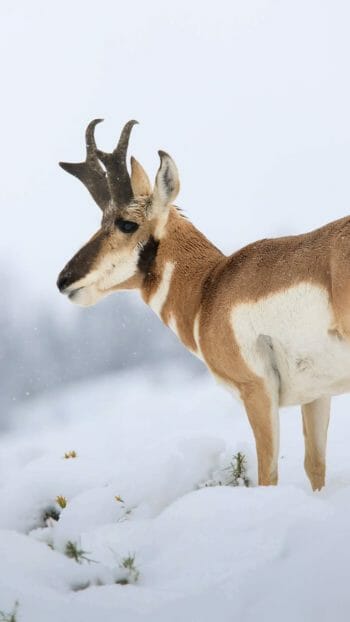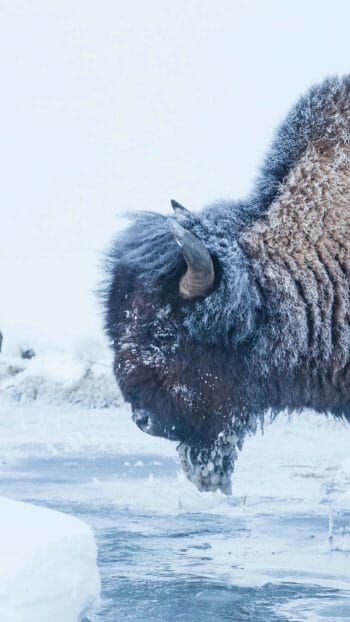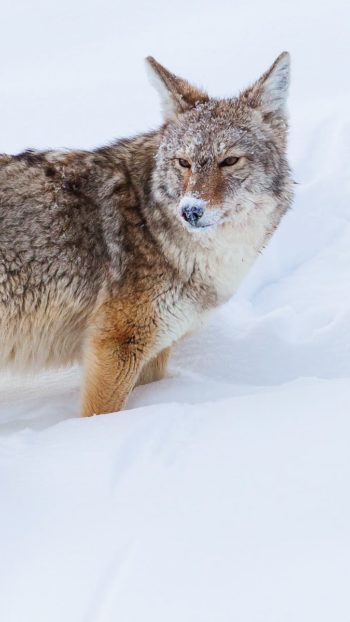Search
Special Interest Safaris
Snowshoe Tours

Experiencing Yellowstone National Park on snowshoes is a unique and enriching way to connect with one of America’s most iconic natural landscapes. The winter months offer an entirely different perspective of the park compared to the bustling summer season. Snowshoeing allows our guests to access areas that are otherwise inaccessible due to deep snow, offering a peaceful and serene experience in the heart of winter’s beauty. The quiet stillness of Yellowstone in winter, with its snow-covered landscapes, frozen waterfalls, and magnificent mountains, provides a one-of-a-kind opportunity to appreciate this wilderness environment.
Snowshoeing has a rich history that dates back thousands of years. Early versions of snowshoes were developed by indigenous peoples in cold, snow-covered regions to help them travel across deep snow without sinking. These early snowshoes were typically made from natural materials such as wood, rawhide, and animal sinew. Over time, the design evolved as the practice spread across the world, particularly to North America, where Native American tribes used snowshoes for hunting, trapping, and travel during the winter months. The need for snowshoes became particularly important in mountainous regions with deep snow, where conventional footwear would have been insufficient for crossing vast stretches of wilderness.
More recently, snowshoeing has grown in popularity among explorers and adventurers. While cross-country skiing and downhill skiing, at both resorts and in the backcountry, have soared in popularity, snowshoeing has been quietly ascending as a more immersive and gentle way to visit snow-covered ecosystems. The technology mimics a snowshoe hare’s oversized paws which spread its weight out over the snow, preventing sinking. Walking in deep snow becomes much more manageable with the big shoes on our boots. It is an activity that anyone can partake in from children to adults. As long as one can walk, one can snowshoe.
Additionally, snowshoeing in Yellowstone gives visitors a chance to experience the park’s wildlife and their stories they leave behind. Wildlife such as bison, wolves, and elk are certainly visible, and some of the smaller wonders such as owls, american dippers, otters and sheep as guide favorites. Every creature leaves their tracks in the snow, and we can interpret moments of chase, feeding and resting in an immersive way unique to the winter season. Every new corner holds the possibility of discovery.
Snowshoeing allows for an intimate experience, where you can witness the park’s diverse ecosystems from a closer perspective, without disturbing the animals or the environment. The combination of physical activity, breathtaking scenery, and the opportunity to connect with the park’s natural rhythms makes snowshoeing in Yellowstone a memorable and rewarding winter adventure.
FAQs
Can my child join me on a snowshoeing safari?
Yes, we can take out anyone over 50lbs in size. Most companies do not make snowshoe equipment for anyone smaller than that. This usually equates to ages 6 and older (depending, of course, on the child). We have also taken out families with younger children that the parents opt to carry in backpacks. This is an option to be decided on at the discretion of the family. We do spend several hours outside in cold and snowy conditions, so this is an important factor to consider for overall enjoyment and comfort. Our office team is always willing to discuss options that will be the best fit for each family with children.
Will the snowshoe tour still run in harsh weather?
We will operate our snowshoe safaris in all weather conditions as long as roads are open for us to access the regions in Yellowstone we are hoping to enjoy. If roads close, we will cancel a tour. Our guides are very knowledgeable about the weather and environment, and will choose locations for snowshoeing that are most appropriate and comfortable for variable conditions. For example, if it is snowing heavily, we opt for snowshoeing in the forest, where tall evergreens offer protection from the snow. On particularly windy days, we will opt for the lee side of any hill or mountain, and again utilize the forest for protection. On very cold days, we may opt for shorter time outside, and will provide hand and foot warmers as well as hot beverages and snacks to stay fueled. If the temperatures are below zero, we will assess the safety of offering these safaris, and may offer other options instead.
Will we get to see wildlife on a snowshoe safari?
Yes, our region is rich with wildlife. Our snowshoe safaris into Yellowstone’s Northern Range will encounter a wide variety of animals seen on the drive and out on the trails. Bison, elk, bighorn sheep, pronghorn, coyotes and birds of prey are all likely. Wolves and moose are also possible in winter months. Rarer animals such as owls and otters are also possible. On our snowshoeing tours from Big Sky we can also encounter elk, coyotes and eagles. The tracks we encounter on our treks often tell stories of snowshoe hare, pine marten, ermine, red squirrels, magpie and ravens, and predation from raptors such as owls and hawks. Every day is different, but we always see wildlife or evidence of wildlife.
Can I book a snowshoe tour from Big Sky?
Yes we offer two snowshoe options from Big Sky. Our Half Day Snowshoe Safari is offered each morning and afternoon from December to March. Our Big Sky Adventure is also offered during the winter months. Both tours offer a pickup at a central meeting point. Our guide will meet and prepare you for the tour, then and head south over the border of Yellowstone National Park where we do not have to enter an official gate. We have a myriad of trails to choose from along this stretch of the Park. Trailheads are anywhere from 10 to 30 minutes away from Big Sky. We normally spend about 2 hours on the trail before returning to town again. On our Big Sky Adventure we will snowshoe and then continue south towards the town of West Yellowstone to enjoy a hot meal and a private tour of the Grizzly and Wolf Discovery Center to see grizzly bears and wolves in an amazing outdoor enclosure while learning about Yellowstone’s ecology.
Can I join a snowshoe safari as a first timer?
Yes. Our guides are experienced in training on snowshoeing and will help you every step of the way. They will instruct on the placement, use and enjoyment of all snowshoe equipment including the shoes, poles and backpacks we provide to every guest on every tour. There is a small learning curve in feeling deep snow vs packed down snow, learning to keep your balance and walking with a slightly more open stance, but people pick up on all of these really quickly! The joy of snowshoeing is there is no skill required, and the point is to explore and have fun. There is no need for speed, so trial and error is absolutely ok.
We were only in North Yellowstone for three days, so we had to make the most of it. And are we happy we contracted Yellowstone Safari Company. Our guide was the absolute BEST. We had some luck on our side too, but we saw wolves, moose, a black bear den, coyote, and so much more. Our guide led our family of four on a snowshoe hike where we discovered foot prints of snowshoe rabbits, weasels and mice. It was fantastic and very worth the investment!


